Showing 21–25 of 28 results
-
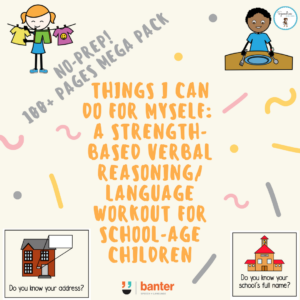
$12.00 including GST
In this 102-page No-Prep Mega Pack, we have embraced the theme of ‘Things I can do for myself’.
Specific goals you can target with this resource
- Goal 1: Why do things happen? Auditory bombardment of complex sentences containing the subordinating conjunction, ‘because’. Cause/effect relationships (page 5-11)
- Goal 2: Sequencing Objects (page 12-19)
- Goal 3: Processing and producing negative questions (page 20-34)
- Goal 4: Generating a logical explanation for a problem. Generating a possible solution for the problem (page 35-47)
- Goal 5: Logical predictions and possible solutions based on basic knowledge of the world (page 48-62)
- Goal 6: Divergent Thinking (page 63-74)
- Goal 7: To draw inferences from facts given and from general knowledge (page 75-81)
- Goal 8: Explaining tasks and abilities using sequenced procedures (page 82-95)
- Goal 9: Setting a plan for things the student can do for themselves (page 96-101).
-
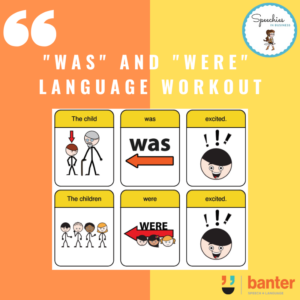
$9.00 including GST
Before the age of around 5 years, typically developing children start to make sentences using different forms of the copula verb “to be” in past tense: “was” and “were”.
Many people – including lots of people learning English as a second language and people with language disorders – have difficulties using words like “was” or “were” in sentences.
This 81-page non-preparation pack is designed to provide people in this situation with focused, scaffolded practice of the form, using regular and irregular plurals.
-
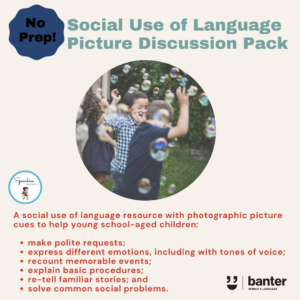
$5.99 including GST
This simple 15-page no-prep resource is designed to help students learn more about some basic social uses of language, and to practice expressing themselves socially in several different ways in familiar contexts, including:
- making polite requests;
- expressing different emotions, including with tones of voice;
- recounting memorable events (e.g. celebrations);
- explaining basic procedures (e.g how to pack a school bag, and play sports and games);
- re-telling familiar stories (e.g. fairy tales); and
- solving common social problems (e.g. needing to go to the bathroom during class).
This resource is not intended to prescribe “correct” or “expected” behaviours, but instead to give students the opportunity to learn about different social uses of language from adults and peers and to express their thoughts and feelings using words.
Suitable for face-to-face and distance learning.
-
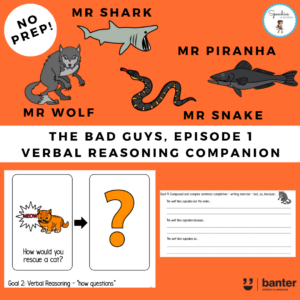
$11.00 including GST
In this 67-page no-prep oral language companion to “The Bad Guys”, we have adopted some of the language used in the book to create a verbal reasoning workout that’s fun, thought-provoking, and challenging.
Contents included in this pack:
- Page 5: Verbal Reasoning – Why Can’t…?
- Page 6-12: Verbal Reasoning – “how” questions
- Page 13-26: Blank’s language level 4: Which one wouldn’t you use?
- Page 27-33: Sentences with auxiliary verbs “has” and “does”
- Page 34-37: Following directions (complex: before and after)
- Page 38-44: What would happen if…?
- Page 45-49: Passive sentence practice
- Page 50-56: Verbal reasoning: Why did it happen?
- Page 57-62: Compound and complex sentence completion – writing exercise – but, so, because…
- Page 63-66: Why is X made of Y?
-
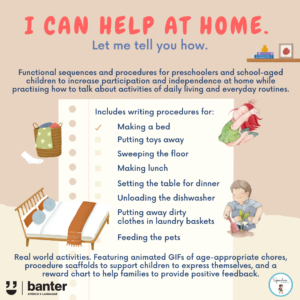
$6.99 including GST
This 29-page resource is designed to support children to explain procedures for everyday activities, using animated GIFs and a language scaffold to help children to express themselves.
The resource is suitable for oral and written procedures, with space for older students to write responses.
We also include a simple chore (reward) chart that parents and other caregivers can use to give positive feedback to children about how independent and helpful they are.





